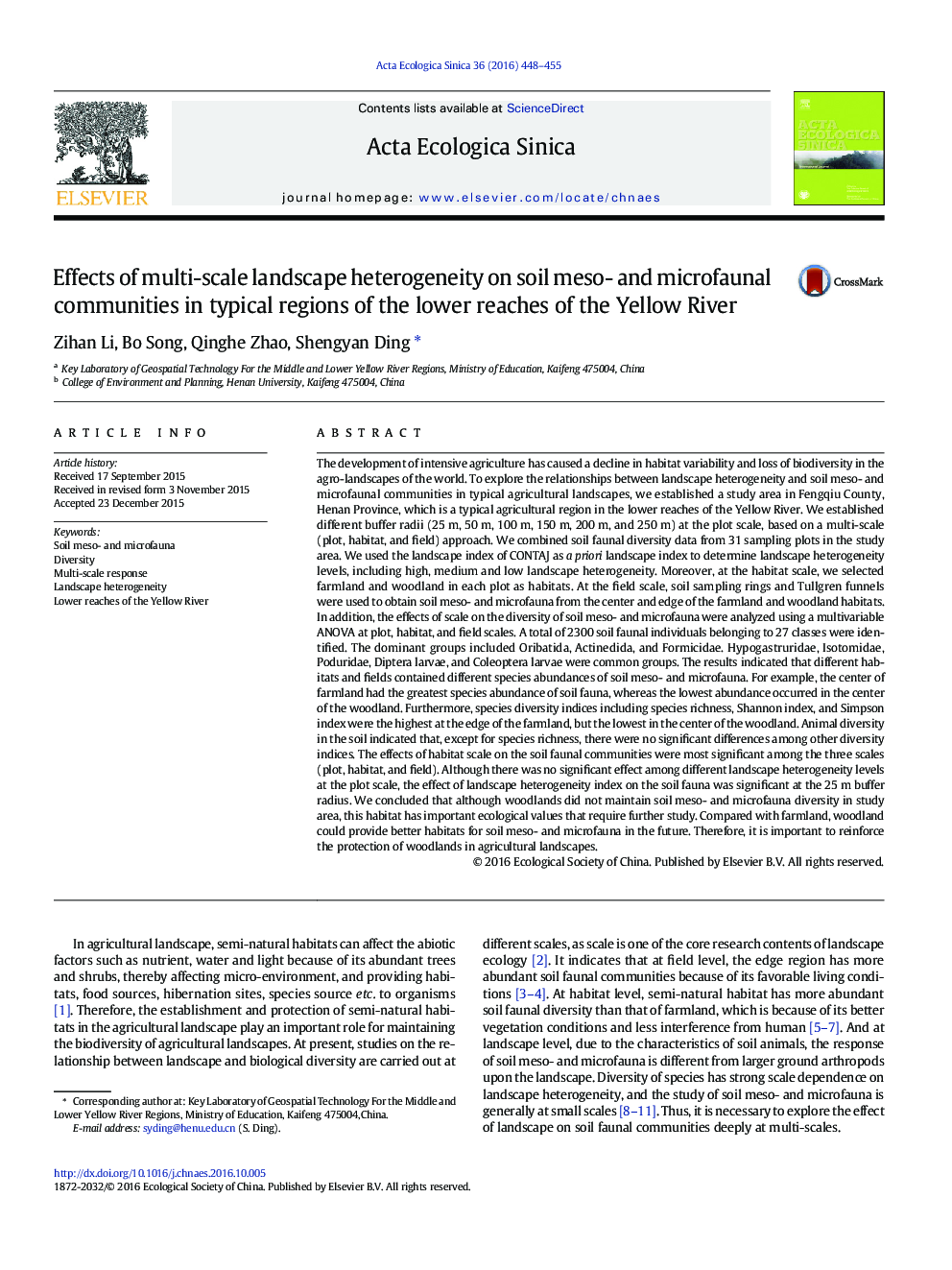| کد مقاله | کد نشریه | سال انتشار | مقاله انگلیسی | نسخه تمام متن |
|---|---|---|---|---|
| 8846416 | 1617677 | 2016 | 8 صفحه PDF | دانلود رایگان |
عنوان انگلیسی مقاله ISI
Effects of multi-scale landscape heterogeneity on soil meso- and microfaunal communities in typical regions of the lower reaches of the Yellow River
ترجمه فارسی عنوان
اثرات ناهمگونی چشم انداز چند مقیاس بر روی جوامع مضر و میکرو فاونال در مناطق متداول در ساحات پایین رود زرد
دانلود مقاله + سفارش ترجمه
دانلود مقاله ISI انگلیسی
رایگان برای ایرانیان
کلمات کلیدی
خاک مازو و میکروفون، تنوع پاسخ چندگانه، ناهمگونی چشم انداز، پایین تر از رودخانه زرد،
موضوعات مرتبط
علوم زیستی و بیوفناوری
علوم کشاورزی و بیولوژیک
بوم شناسی، تکامل، رفتار و سامانه شناسی
چکیده انگلیسی
The development of intensive agriculture has caused a decline in habitat variability and loss of biodiversity in the agro-landscapes of the world. To explore the relationships between landscape heterogeneity and soil meso- and microfaunal communities in typical agricultural landscapes, we established a study area in Fengqiu County, Henan Province, which is a typical agricultural region in the lower reaches of the Yellow River. We established different buffer radii (25Â m, 50Â m, 100Â m, 150Â m, 200Â m, and 250Â m) at the plot scale, based on a multi-scale (plot, habitat, and field) approach. We combined soil faunal diversity data from 31 sampling plots in the study area. We used the landscape index of CONTAJ as a priori landscape index to determine landscape heterogeneity levels, including high, medium and low landscape heterogeneity. Moreover, at the habitat scale, we selected farmland and woodland in each plot as habitats. At the field scale, soil sampling rings and Tullgren funnels were used to obtain soil meso- and microfauna from the center and edge of the farmland and woodland habitats. In addition, the effects of scale on the diversity of soil meso- and microfauna were analyzed using a multivariable ANOVA at plot, habitat, and field scales. A total of 2300 soil faunal individuals belonging to 27 classes were identified. The dominant groups included Oribatida, Actinedida, and Formicidae. Hypogastruridae, Isotomidae, Poduridae, Diptera larvae, and Coleoptera larvae were common groups. The results indicated that different habitats and fields contained different species abundances of soil meso- and microfauna. For example, the center of farmland had the greatest species abundance of soil fauna, whereas the lowest abundance occurred in the center of the woodland. Furthermore, species diversity indices including species richness, Shannon index, and Simpson index were the highest at the edge of the farmland, but the lowest in the center of the woodland. Animal diversity in the soil indicated that, except for species richness, there were no significant differences among other diversity indices. The effects of habitat scale on the soil faunal communities were most significant among the three scales (plot, habitat, and field). Although there was no significant effect among different landscape heterogeneity levels at the plot scale, the effect of landscape heterogeneity index on the soil fauna was significant at the 25Â m buffer radius. We concluded that although woodlands did not maintain soil meso- and microfauna diversity in study area, this habitat has important ecological values that require further study. Compared with farmland, woodland could provide better habitats for soil meso- and microfauna in the future. Therefore, it is important to reinforce the protection of woodlands in agricultural landscapes.
ناشر
Database: Elsevier - ScienceDirect (ساینس دایرکت)
Journal: Acta Ecologica Sinica - Volume 36, Issue 6, December 2016, Pages 448-455
Journal: Acta Ecologica Sinica - Volume 36, Issue 6, December 2016, Pages 448-455
نویسندگان
Zihan Li, Bo Song, Qinghe Zhao, Shengyan Ding,
